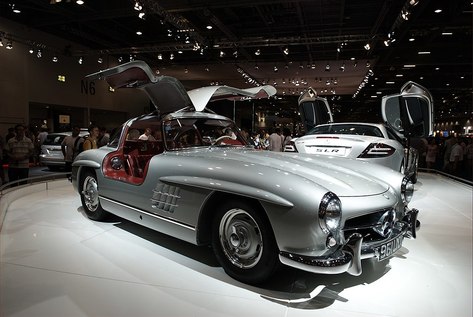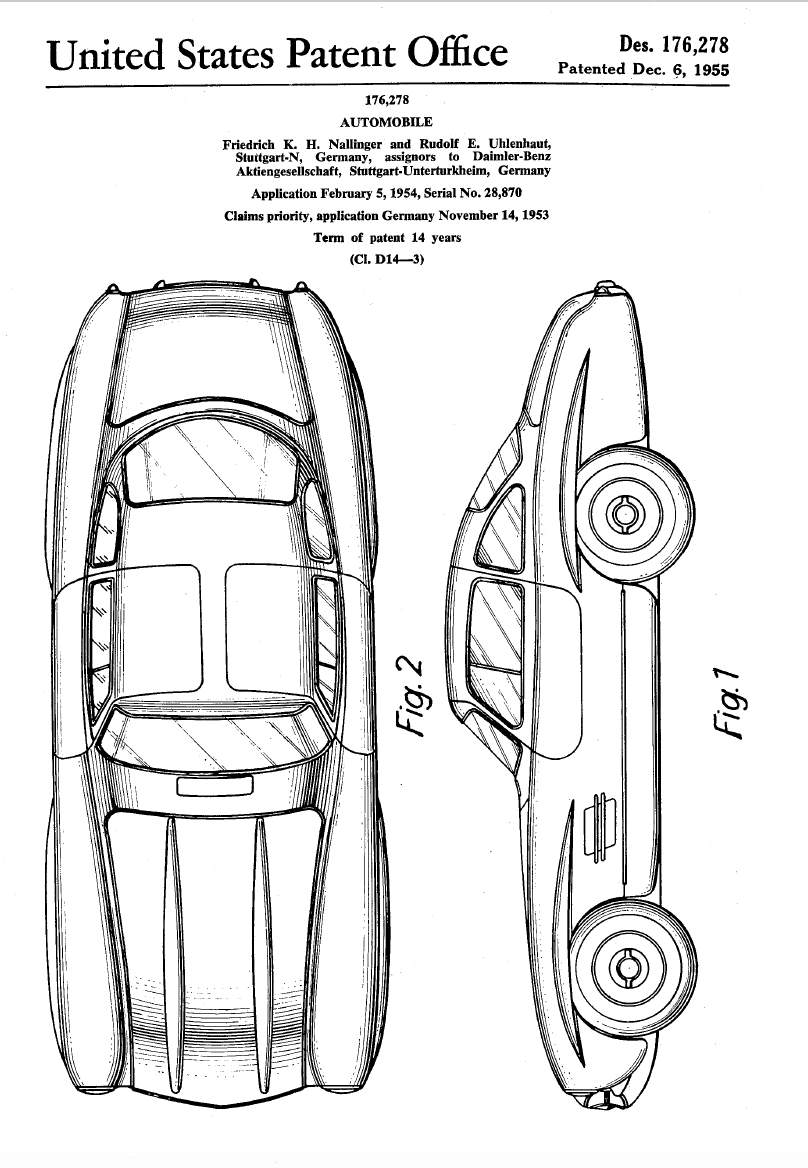 Mercedes-Benz 300 SL (Photo by Gerard McGovern from London, United Kingdom)
Mercedes-Benz 300 SL (Photo by Gerard McGovern from London, United Kingdom)
On December 6, 1955, U.S. Design Patent No.: Des 176,278 issued to Friedrich K. H. Nallinger and Rudolf E. Uhlenhaut, both of Germany. The design was for the iconic Mercedes-Benz 300 SL produced by Daimler Benz AG and commonly referred to as the "Gullwing" because of its unique doors. The 300 SL production car was based on a race car, also known as the 300 SL. The race car had the internal designation W194, while the production car had the internal designation W198.
The 300 SL (W194) was introduced to the racing world in 1952. Surprisingly, the engine of the 300 SL (W194) was a small 3.0 liter inline six that only produced 170 horsepower, which was rather underwhelming for a race car. However, what the 300 SL (W194) lacked in power, it made up for with its revolutionary chassis and body design. Instead of having a traditional platform-type chassis, the 300 SL (W194) had a welded aluminum tube spaceframe chassis that weighed only 150 pounds. The design of the chassis made it impossible to use traditional doors, so the distinctive gull-wing doors were used instead. At first, Daimler Benz was concerned that this door design would be frowned upon by racing officials. But after carefully reading all the pertinent rule books, the head of Daimler Benz racing, Alfred Neubauer famously declared "Nowhere is it written that a door can only open sideways."
The unique construction of the 300 SL (W194) made it a highly successful race car. In 1952 alone, the 300 SL (W194) took second and fourth at its Mille Miglia debut, took first and second at Le Mans and finished first, second and third at Nürburgring. This success, coupled with the good looks of the 300 SL (W194) prompted Daimler-Benz's official U.S. importer, Max Hoffman, to convince company officials to make a production version of the 300 SL (W194).
The production version 300 SL (W198) debuted in 1955. The body of the production version was changed to be sleeker and more stylish. However, it still retained the famous gull wing doors. In order to facilate ingress to and egress from the car interior, the 300 SL (W198) was provided with a tilt steering wheel. Another innovation that was provided was direct fuel injection, the first ever in a production car. The fuel injectors increased the horsepower of the 300 SL (W198) to close to 240 horsepower and gave it a top speed of 160 mph, making it the fastest production car up to that time.
In order to accomodate the fuel injectors, a raised ridge had to be formed in the hood of the 300 SL (W198). For purposes of symmetry, a second, parallel raised ridge was formed in the hood as well. These two raised ridges can be seen in the photo and design patent above.
The 300 SL (W194) was introduced to the racing world in 1952. Surprisingly, the engine of the 300 SL (W194) was a small 3.0 liter inline six that only produced 170 horsepower, which was rather underwhelming for a race car. However, what the 300 SL (W194) lacked in power, it made up for with its revolutionary chassis and body design. Instead of having a traditional platform-type chassis, the 300 SL (W194) had a welded aluminum tube spaceframe chassis that weighed only 150 pounds. The design of the chassis made it impossible to use traditional doors, so the distinctive gull-wing doors were used instead. At first, Daimler Benz was concerned that this door design would be frowned upon by racing officials. But after carefully reading all the pertinent rule books, the head of Daimler Benz racing, Alfred Neubauer famously declared "Nowhere is it written that a door can only open sideways."
The unique construction of the 300 SL (W194) made it a highly successful race car. In 1952 alone, the 300 SL (W194) took second and fourth at its Mille Miglia debut, took first and second at Le Mans and finished first, second and third at Nürburgring. This success, coupled with the good looks of the 300 SL (W194) prompted Daimler-Benz's official U.S. importer, Max Hoffman, to convince company officials to make a production version of the 300 SL (W194).
The production version 300 SL (W198) debuted in 1955. The body of the production version was changed to be sleeker and more stylish. However, it still retained the famous gull wing doors. In order to facilate ingress to and egress from the car interior, the 300 SL (W198) was provided with a tilt steering wheel. Another innovation that was provided was direct fuel injection, the first ever in a production car. The fuel injectors increased the horsepower of the 300 SL (W198) to close to 240 horsepower and gave it a top speed of 160 mph, making it the fastest production car up to that time.
In order to accomodate the fuel injectors, a raised ridge had to be formed in the hood of the 300 SL (W198). For purposes of symmetry, a second, parallel raised ridge was formed in the hood as well. These two raised ridges can be seen in the photo and design patent above.


